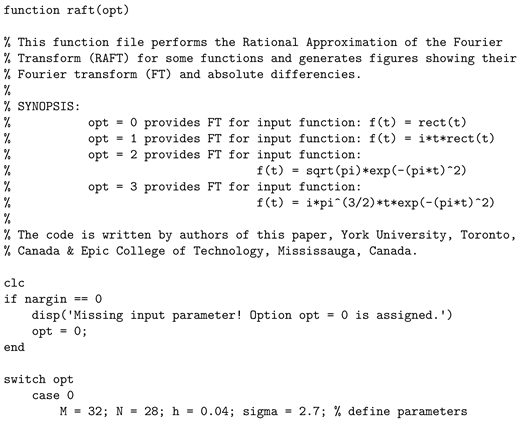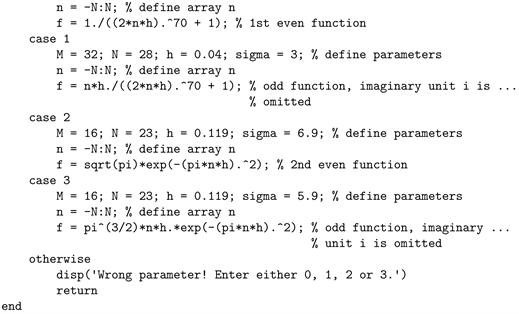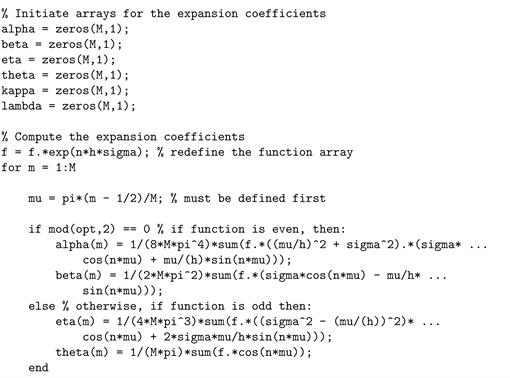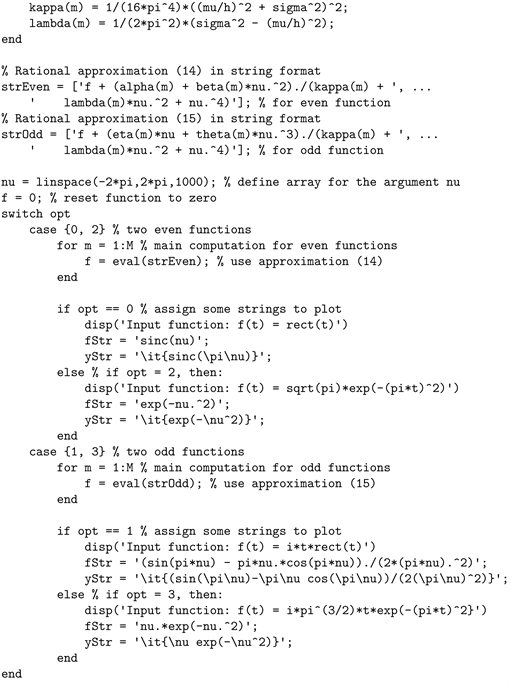A Rational Approximation of the Fourier Transform by Integration with Exponential Decay Multiplier ()
1. Introduction
The forward and inverse Fourier transforms of two related functions
and
can be defined in a symmetric form as [1] [2]:
(1)
and:
(2)
where variables t and
are the corresponding Fourier-transformed arguments in t-space and
-space, respectively (time t vs. frequency
, for example).
Fourier transform methods are widely used in many applications including signal processing [1] [2], spectroscopy [3] [4] and computational finance [5] [6] [7].
There are several efficient methods that have been reported for rational approximations in literature. For example, the rational approximations may be built on the basis of the Newman nodes [8], Chebyshev nodes [9], logarithmic nodes [10] and so on.
Recently we have reported a new method of rational approximation of the Fourier transform (1) as given by [11]:
(3)
where M is an integer determining the number of summation terms
,
is a shift constant,
is a decay (damping) constant and:
are expansion coefficients.
It has been noticed that approximation (3) is not purely rational and there was a question whether or not a rational function of the Fourier transform (1) in explicit form without any trigonometric multiplier of the kind:
(4)
depending on the argument
, can be obtained [12]. Theoretical analysis shows that this trigonometric multiplier originating from the shifting property of the Fourier transform can be indeed excluded. As a further development of our work [11], in this paper, we derive a rational function of the Fourier transform (1) that has no any trigonometric multiplier of the kind (4). Therefore, it can be used as an alternative to the Padé approximation. To the best of our knowledge, this method of rational approximation of the Fourier transform (1) for a non-periodic function
has never been reported in scientific literature.
2. Derivation
2.1. Preliminaries
Assume that
is even while
is odd such that
, but
and
. Then it is not difficult to see that the Fourier transform (1) of the function
can be expanded into two integral terms as follows:
Assume also that the function
behaves in such a way that for some positive numbers
and
the following integrals:
and:
are negligibly small and can be ignored in computation. Consequently, we can approximate the Fourier transform as given by:
(5)
Further the values
and
will be regarded as widths (pulse widths) for the real and imaginary parts of the function
, respectively.
2.2. New Sampling Method
Consider a sampling Formula (see, for example, Equation (3) in [13] ):
(6)
where:
is the sinc function,
is a set of sampling points, h is small adjustable parameter (step) and
is error term. François Viète discovered that the sinc function can be represented by cosine product1 [14] [15]:
(7)
In our earlier publications we introduced a product-to-sum identity [16]:
(8)
and applied it for sampling [17] [18] as incomplete cosine expansion of the sinc function for efficient computation of the Voigt/complex error function. It is worth noting that this product-to-sum identity has also found some efficient applications in computational finance [6] [19] [20] involving numerical integration.
Comparing identities (7) and (8) immediately yields:
Unlike Equation (7), this limit consists of sum of cosines instead of product of cosines. As a result, its application provides significant flexibilities in various numerical integrations [6] [17] [18] [19] [20].
Change of variable
in the limit above leads to:
Therefore, by truncating integer M and by making another change of variable
we obtain:
(9)
The right side of Equation (9) is periodic due to finite number of the summation terms. As a result, the approximation (9) is valid only within the interval
.
At equidistantly separated sampling grid-points such that
, the substitution of approximation (9) into sampling Formula (6) gives:
(10)
It is important that in sampling procedure the total number of the sampling grid-points
as well as the step h should be properly chosen to insure that the widths
and
are entirely covered.
As we can see, the sampling Formula (10) is based on incomplete cosine expansion of the sinc function that was proposed in our previous works [17] [18] as a new approach for rapid and highly accurate computation of the Voigt/complex error function [21] [22] [23]. Computations we performed show that this method of sampling is particularly efficient in numerical integration.
2.3. Even Function
Suppose that our objective is to approximate the sinc function
. First we take the inverse Fourier transform (2) of the sinc function:
where:
is known as the rectangular function. This function is even since
. The rectangular function
has two discontinuities at
and
. Therefore, it is somehow problematic to perform sampling over this function. However, we can use the fact that:
(11)
Thus, by taking a sufficiently large value for the integer k, say
, we can approximate the rectangular function (11) quite accurately as:
Figure 1 shows the function
by blue curve. As we can see from this figure, the function very rapidly decreases at
with increasing t. Therefore, we can take
. Thus, the width of this function is
.
Sampling of function
in accordance with Equation (10) results in a periodic dependence. Consequently, due to periodicity on the right side of Equation (10) it cannot be utilized for rational approximation of the Fourier transform. However, this problem can be effectively resolved by sampling the function
instead of
itself. This leads to:
(12)
Figure 2 shows the results of computation for even function
by approximation (12) at
,
,
with
(blue curve),
(red curve) and
(green curve). As we can see from this figure, all three curves are periodic as expected. However, if the constant
is big enough, then slight rearrangement of Equation (12) in form:
(13)
can effectively eliminate this periodicity due to presence of the exponential decay multiplier
on the right side. This suppression effect can be seen from
![]()
Figure 1. The even
and odd
functions shown by blue and red curves, respectively.
![]()
Figure 2. Approximation (12) to the function
computed at
,
,
with
(blue curve),
(red curve) and
(green curve).
Figure 3 illustrating the results of computation for the even function
by approximation (13) at
,
with
(blue curve),
(red curve) and
(green curve). As it is depicted by blue curve, at
the function is periodic. However, as decay coefficient
increases, the exponential multiplier
suppresses all the peaks (except the first peak at the origin) such that the resultant function tends to become solitary along the entire positive t-axis. This tendency can be observed by red and green curves at
and
, respectively. As a consequence, if the damping multiplier
is big enough, say greater than unity, the approximated function becomes practically solitary as the original function
itself.
Thus, substituting approximation (13) into Equation (5) and considering the fact that at sufficiently large
the function becomes solitary along positive x-axis, the upper limit
of integration can be replaced by infinity as2:
This integral can be taken analytically in form of rational function now and after some trivial rearrangements that exclude double summation, it follows that
(14)
where the expansion coefficients are given by:
![]()
Figure 3. Evolution to the function
computed by approximation (13) at
,
,
with
(blue curve),
(red curve) and
(green curve).
and:
Figure 4 shows the original sinc function
and its approximation (14) within the interval
at
,
,
and
by black dashed and light blue curves, respectively. These two curves are not visually distinctive.
2.4. Odd Function
Consider, as an example, the following function:
We can see that the condition
for odd function in its imaginary part is satisfied. The function
is shown in Figure 1 by red curve. We can take
and the width is
.
Using exactly same procedure as it has been described above and considering the fact that at sufficiently large
the upper limit
of integration can be replaced by infinity, we can write3:
![]()
Figure 4. Approximations of the functions
and
within interval
. Both approximations are obtained by Equations (14), (15) for input functions
and
at
,
,
,
(light blue curve) and at
,
,
,
(gray curve), respectively. The original functions
and
are also shown by black dashed curves for comparison.
This leads to:
(15)
where the expansion coefficients are:
and:
The Fourier transform of the function
can be readily found analytically:
Gray curve in Figure 4 illustrates the Fourier transform of the function
obtained by using approximation (15) at
,
,
and
. The original function:
is also shown for comparison by black dashed curve. These two curves in the interval
are also not distinctive visually.
3. Accuracy
Figure 5 shows the absolute difference between original sinc function
and its approximation (14) for input function
calculated at
,
,
and
. As we can see, the absolute difference within the interval
does not exceed 2.5 × 10−3. This accuracy is better than that of shown in our recent publication, where we used Equation (3) for the sinc function approximation (see Figure 6 in [11] ).
Figure 6 shows the absolute difference between original function given by
and its approximation (15) for input function
calculated at
,
,
and
. We can see that the absolute difference within the interval
does not exceed 6 × 10−4.
It should be noted that with more well-behaved functions we can obtain considerably higher accuracies. For example, suppose that we need to obtain the Fourier transform of the function
by using approximations (14) and (15). Analytically, its Fourier transform is:
![]()
Figure 5. Absolute difference between the original sinc function
and its rational approximation (14) for input function
at
,
,
and
.
![]()
Figure 6. Absolute difference between the original function
and its rational approximation (15) for input function
at
,
,
and
.
where
is the Fourier transform of
while
is the Fourier transform of
.
Blue curve in Figure 7 corresponds to the absolute difference between function
and its approximation (14) for input function
at
,
,
and
. Red curve in Figure 7 corresponds to the absolute difference between function
and its approximation (15) for input function
at
,
,
and
. We can see that with only 16 summation terms the absolute differences do not exceed 3 × 10−10 and 9 × 10−10. These results demonstrate that the rational approximations (14) and (15) can be highly accurate in the Fourier transform of well-behaved functions.
In our recent work [24] we applied alternative method of sampling by using incomplete cosine expansion of the Gaussian function of kind
, where c and h are the fitting parameters. We have shown that this method of sampling can also be used to obtain high-accuracy computation of the Voigt/complex error function. In our future work will apply this method of sampling as an alternative that may reduce the absolute difference for rational approximations of the piecewise functions with discontinuities.
4. Alternative Representation
For a function
, where its real part
is even and its imaginary part
is odd, we can write:
or:
![]()
Figure 7. Absolute difference between the original functions
and its approximation (14) for input function
at
,
,
and
(blue curve). Absolute difference between the original functions
and its approximation (15) for input function
at
,
,
and
(red curve).
Using a Computer Algebra System (CAS) supporting symbolic programming it is not difficult to find coefficients
and
to represent this approximation as:
(16)
where:
and:
are polynomials of the orders
and
, respectively.
Padé approximation is one of the efficient methods to represent a function in form of ratio of two polynomials. Our preliminary numerical results show that the proposed new method of rational approximation may significantly extend the range
in coverage [12] than the conventional Padé approximation.
5. MATLAB Code and Description
The MATLAB code shown below is written as a function file raft.m that can be simply copied and pasted to create m-file in the MATLAB environment. The name of this function file originates from the abbreviation RAFT that stands for Rational Approximation of the Fourier transform. The command raft(opt) performs sampling and then computation of the expansion coefficients
,
,
,
,
,
,
. Once the coefficients are determined, the program executes the Fourier transform according to Equations (14) and (15) for even and odd input functions, respectively. The results of computations are generated in two plots. The first plot shows the Fourier transform of input function while the second plot illustrates its absolute difference.
There are four option values for opt argument. At opt = 0, opt = 1, opt = 2 and opt = 3 the corresponding input functions are
,
,
and
. The default value is opt = 0 signifying that for the commands without argument raft and raft(), the value zero for opt is assigned.
The authors did not attempt to optimize the code but rather to write it in a simple way with required comment lines in order to make it clear and intuitive for reading. The program was built and tested on MATLAB 2014a. However, the code should run in any version of MATLAB since it utilizes the most common commands.





6. Conclusions
In this work we derived a rational approximation of the Fourier transform that with help of a CAS can be readily rearranged as:
This method of the rational approximation is based on integration involving an exponential decay multiplier
. The computational test we performed shows that this method of the Fourier transform can provide relatively accurate approximations even for the functions with discontinuities like
and
. Furthermore, this method shows that for the well-behaved function
with only 16 summation terms the rational approximations (14) and (15) provide the Fourier transform with absolute differences not exceeding 3 × 10−10 and 9 × 10−10 for its real and imaginary parts, respectively. Our preliminary results indicate that the proposed method may be promising for rational approximation over the wide range
.
Acknowledgements
This work is supported by the National Research Council Canada, Thoth Technology Inc., York University and Epic College of Technology.
NOTES
1This equation is also attributed to Euler.
2For this integration we imply that the interval
along t-axis occupied by sampling grid-points is larger than the function width
.
3In this integration we imply again that the interval
along t-axis occupied by sampling grid-points is larger than the function width
.